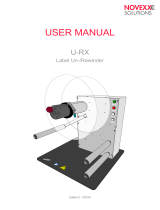
3.2.1 System Requirements
The center winder system has some minimum requirements for proper operation.
• Frequency converter: VLT AutomationDrive with VLT Center Winder MCO 352. It is also recommended that the drive have dynamic braking
option capabilities to allow a quick stop of a large roll.
• Winder motor: The motor needs to be inverter duty with a wide speed range (>100:1). The motor should be geared or belted so that top motor
speed at core does not exceed 4500 RPM. Generally, the motor maximum constant horsepower speed will be the limiting factor.
• Winder Encoder: The winder encoder needs to be mounted on the winder motor. The encoder must have a differential, quadrature TTL/5VDC
output. The encoder PPR should be selected such that the channel frequency is as close to 400 kHz at the winder motor top speed.
• Line Encoder: The line speed encoder output circuitry needs to be the same as the winder encoder. Again, the encoder PPR should selected
such that the channel frequency is as close to 400 kHz at the maximum line speed.
• Tension Feedback: The tension feedback is required from either a load cell or dancer. If load cells are used they need to be calibrated for a
either a 0-20 mA or 0-10 V signal from zero to maximum tension. If a dancer is used the calibration should be 0-20mA/0-10V from bottom to
top of the dancer movement.
• Logic Inputs: The digital inputs for tension on, over/under etc. are 24 VDC, sinking inputs. The drive has a 24VDC/200mA supply available if dry
contacts are used. Logic commands can also be sent to the drive serial port. Note that a third party HMI/operator display such as EXOR or Red
Lion can be used in place of the digital inputs. It is possible to serially access logic parameters through the VLT AutomationDrive USB or RS485
port.
• Tension and Taper set-points: The tension and taper set-points are available on the display of the drive as parameters and can also be accessed
serially through the VLT AutomationDrive USB or RS485 port. These set points can also be set using any unused 0-20mA/0-10VDC drive input,
using an analog signal or potentiometer
Maximum Winder Motor speed
4500 RPM
Tension Loop Scan Time 30 ms
TLD Time Resolution 25 ms
Quick Stop Scan time 1 ms
Coast Scan Time <1 ms
Tension Loop Response Time 25 ms
Line encoder frequency 100 kHz - 410 kHz
Winder Encoder frequency 100 kHz – 410 kHz
Winder Speed resolution ±16384 qc counts @ 4500 RPM
Digital inputs 24 VDC, sinking
Digital outputs 24 VDC, sourcing
Analog Tension & taper set points 0-10 VDC, 0-20 mADC, 1000 count resolution
Load cell or dancer feedback 0-10 VDC, 0-20 mADC, 1000 count resolution
VLT
®
Center Winder MCO 352 3 Introduction to Center Winder Controller
MG.33.T1.02 - VLT
®
is a registered Danfoss trademark
9
3























